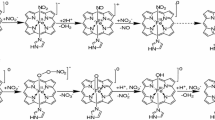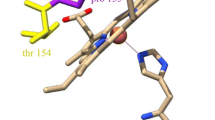Summary
The nitric oxide synthases (NOS), a group of flavo-heme enzymes, biosynthesize a physiologically versatile diatomic messenger, nitric oxide (NO), from the substrate l-arginine (l-Arg). We have examined the active site of the neuronal isoform by electron paramagnetic resonance (EPR) spectroscopy of the ferrous NO complex. The substrate-free NO-bound enzyme exhibits a cytochrome P-450-type EPR spectrum of a typical hexa-coordinate NO heme complex with a nonnitrogenous proximal axial heme ligand. The substrate-free NO complex is rather unstable and spontaneously converts to a cytochrome P-420-type penta-coordinate denatured form. Binding of l-Arg enhances the stability of the hexa-coordinate NO form. The EPR spectrum of the NO adduct of the enzyme-arginine complex has an increased g-anisotropy and well-resolved hyperfine coupling as the result of the 14N of nitric oxide. Significant changes in the NO EPR spectrum were observed on Nω-hydroxy-l-Arg (NHA) binding. These changes are strong indications of a direct interaction between the l-Arg and the bound NO in the distal heme pocket of the enzyme. Electrostatic interactions between the guanidino group of arginine and the bound NO or the steric effect of the substrates appears to affect the Fe-NO geometry, resulting in the observed spectral changes.
Access this chapter
Tax calculation will be finalised at checkout
Purchases are for personal use only
Preview
Unable to display preview. Download preview PDF.
Similar content being viewed by others
References
Masters BSS (1994) Nitric oxide synthases: why so complex? Annu Rev Nutr 14: 131145
Bredt DS, Snyder SH (1994) Nitric oxide: a physiologic messenger molecule. Annu Rev Biochem 63: 175–195
Griffith OW, Stuehr DJ (1995) Nitric oxide synthases: properties and catalytic mechanism. Annu Rev Physiol 57: 707–736
Nathan C, Xie Q (1994) Nitric oxide synthases: roles, tolls, and controls. Cell 78: 915918
White KA, Marietta MA (1992) Nitric oxide synthase is a cytochrome P-450 type hemoprotein. Biochemistry 31: 6627–6631
Stuehr DJ, Ikeda-Saito M (1992) Spectral characterization of brain and macrophage nitric oxide synthases. Cytochrome P-450-like hemeproteins that contain a flavin semiquinone radical. J Biol Chem 267: 20547–20550
McMillan K, Bredt DS, Hirsch DJ, et al. (1992) Cloned, expressed rat cerebellar nitric oxide synthase contains stoichiometric amounts of heme, which binds carbon monoxide. Proc Natl Acad Sci USA 89: 11141–11145
Wang J, Stuehr DJ, Ikeda-Saito M, et al. (1993) Herne coordination and structure of the catalytic site in nitric oxide synthase. J Biol Chem 268: 22255–22258
Sono M, Stuehr DJ, Ikeda-Saito M, et al. (1995) Identification of nitric oxide synthase as a thiolate-ligated heme protein using magnetic circular dichroism spectroscopy—comparison with cytochrome P-450-CAM and chloroperoxidase. J Biol Chem 270: 19943–19948
McMillan K, Masters BSS (1995) Prokaryotic expression of the heme-and flavinbinding domains of rat neuronal nitric oxide synthase as distinct polypeptides: identification of the heme-binding proximal thiolate ligand as cysteine-415. Biochemistry 34: 3686–3693
Dawson JH (1988) Probing structure-function relations in heme-containing oxygenases and peroxidases. Science 240: 433–439
Matsuoka A, Stuehr DJ, Olson JS, et al. (1994) L-Arginine and calmodulin regulation of the heme iron reactivity in neuronal nitric oxide synthase. J Biol Chem 269: 2033520339
Salerno JC, Frey C, McMillan K, et al. (1995) Characterization by electron paramagnetic resonance of the interactions of L-arginine and L-thiocitrulline with the heme cofactor region of nitric oxide synthase. J Biol Chem 270: 27423–27428
McMillan K, Masters BSS (1993) Optical difference spectrophotometry as a probe of rat brain nitric oxide synthase heme-substrate interaction. Biochemistry 32: 9875–9880
Raag R, Poulos TL (1991) Crystal structures of cytochrome P-450-CAM complexed with camphane, thiocamphor, and adamantane: factors controlling P-450 substrate hydroxylation. Biochemistry 30: 2674–2684
Sligar SG, Murray RI (1987) Cytochrome P-450 cm and other bacterial P-450 enzymes. In: Ortiz de Montellano PR (ed) Cytochrome P-450. Plenum, New York, pp 429–503
O’Keeffe DH, Ebel RE, Peterson JA (1978) Studies of the oxygen binding site of cytochrome P-450. Nitric oxide as a spin-label probe. J Biol Chem 253: 3509–3516
Tsubaki M, Hiwatashi A, Ichikawa Y, et al. (1987) Electron paramagnetic resonance study of ferrous cytochrome P-450scc-nitric oxide complexes: effects of cholesterol and its analogues. Biochemistry 26: 4527–4535
Wang J, Rousseau DL, Abu-Soud HM, et al. (1994) Herne coordination of NO in NO synthase. Proc Natl Acad Sci USA 91: 10512–10516
Author information
Authors and Affiliations
Editor information
Editors and Affiliations
Rights and permissions
Copyright information
© 1998 Springer-Verlag Tokyo
About this paper
Cite this paper
Migita, C.T., Salerno, J.C., Masters, B.S.S., Ikeda-Saito, M. (1998). Electron Paramagnetic Resonance Studies on Substrate Binding to the NO Complex of Neuronal Nitric Oxide Synthase. In: Ishimura, Y., Shimada, H., Suematsu, M. (eds) Oxygen Homeostasis and Its Dynamics. Keio University Symposia for Life Science and Medicine, vol 1. Springer, Tokyo. https://doi.org/10.1007/978-4-431-68476-3_37
Download citation
DOI: https://doi.org/10.1007/978-4-431-68476-3_37
Publisher Name: Springer, Tokyo
Print ISBN: 978-4-431-68478-7
Online ISBN: 978-4-431-68476-3
eBook Packages: Springer Book Archive




